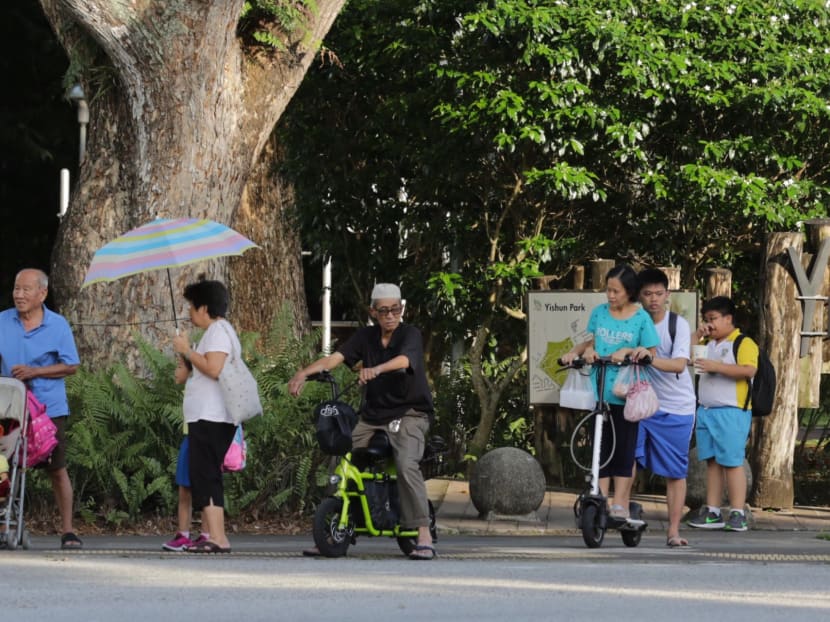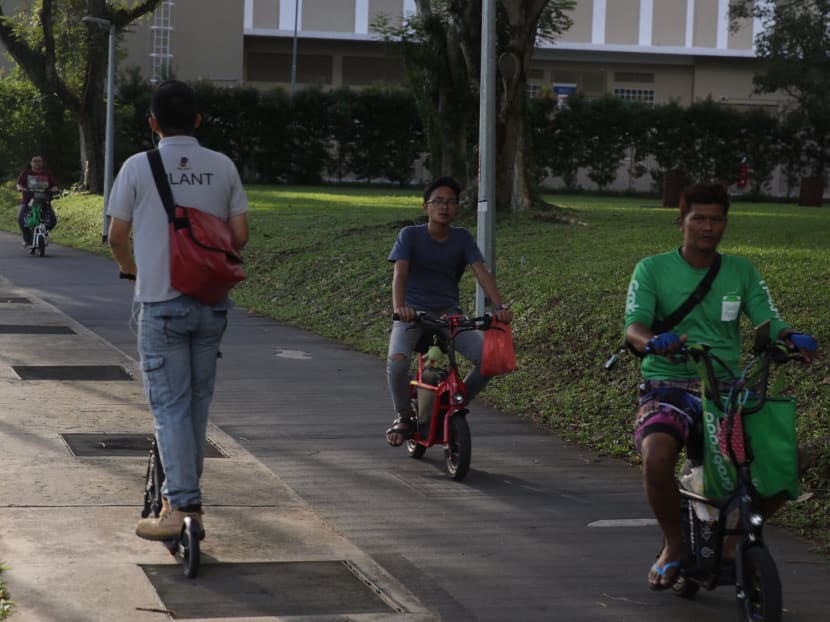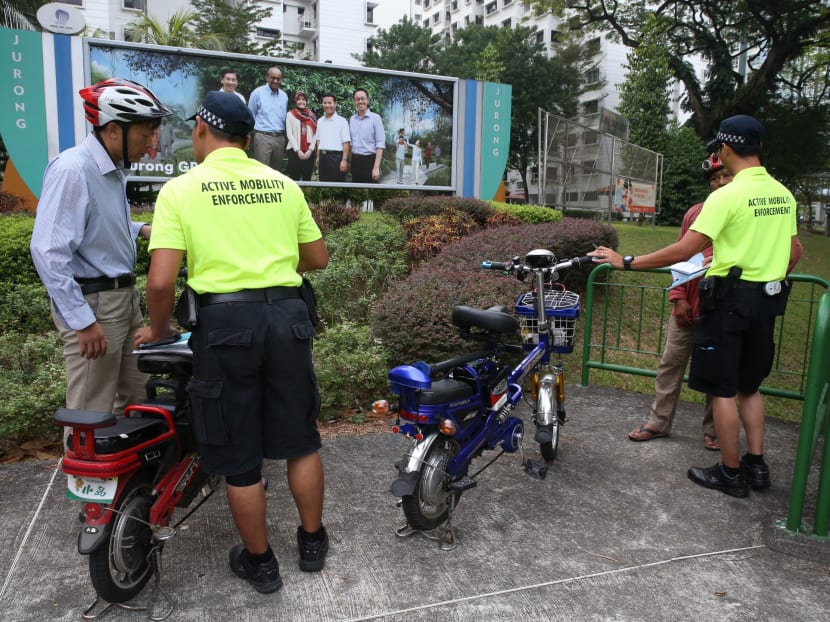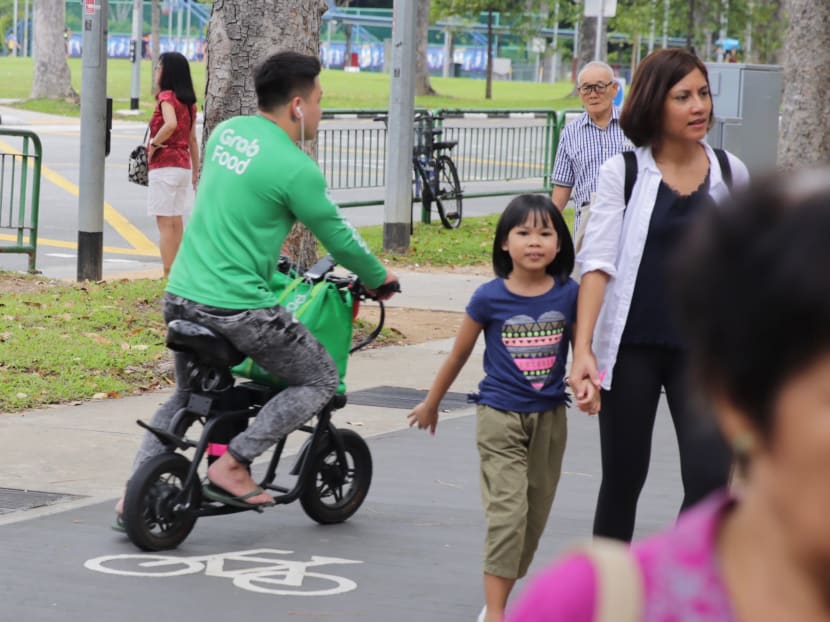The Big Read: Calls to ban PMDs mount as accidents persist — but is it the best option?
SINGAPORE — Some have abandoned their daily walks for fear that they would be hit by a motorised vehicle hurtling down footpaths. Others have had close shaves with impetuous riders.

Popular with riders for daily commutes and deliverymen whose livelihoods depend on them, personal mobility devices (PMDs) include electric scooters, hoverboards and electric unicycles.
SINGAPORE — Some have abandoned their daily walks for fear that they would be hit by a motorised vehicle hurtling down footpaths. Others have had close shaves with impetuous riders.
In recent months, many Singaporeans — including Members of Parliament (MPs) — have joined a growing chorus of condemnation against these motorised vehicles, which have left riders and pedestrians with all manner of injuries from deep cuts to fractures and concussions. There have also been deaths.
Popular with riders for daily commutes and deliverymen whose livelihoods depend on them, these vehicles — known as personal mobility devices (PMDs) in Singapore — include electric scooters, hoverboards and electric unicycles.
Despite efforts to regulate their use, safety concerns persist and calls are mounting to keep them off footpaths and the void decks of public housing estates.
These exhortations come as countries around the world grapple with the dangers posed by these vehicles.
Some have laid down speed limits, barred them from footpaths, or confined them to private land.
Germany this month banned e-scooters from pavements and France will follow suit in September.
In the United Kingdom, roads and pavements are off-limits to e-scooters. They are allowed on private property, such as parks and universities, with the landowner’s permission.
Earlier this month, Dr Lee Bee Wah, an MP for the Nee Soon Group Representation Constituency (GRC), asked in Parliament if Singapore could emulate France’s impending ban.
Allowing PMDs on footpaths shifts “more risks to the pedestrians”, said Dr Lee, who told TODAY that some of her residents feel so unsafe on footpaths that they have “even given up their daily walks”.

There are no signs, however, that a ban in Singapore is on the cards.
Dr Lam Pin Min, Senior Minister of State for Transport, said in reply to Dr Lee that, while the Government was mindful of the safety concerns, the solution was “not to ban them, but to cultivate the right culture where users ride safely and responsibly, and only at the allowed places”.
At the same sitting, there were also calls to ban PMDs from void decks of Housing and Development Board (HDB) estates.
Bukit Batok MP Murali Pillai wondered if the ground-level lift lobbies and areas around letter boxes could be designated pedestrian-only paths under the Active Mobility Act to prevent collisions involving PMDs.
The Act spells out the rules governing the use of PMDs and other equipment on public paths.
Dr Lam replied that void decks are exempted from the Act as they are “not critical for connectivity”.
Therefore, town councils — which take care of public housing estates — can impose their own rules, including barring PMDs from void decks, he said.
More than a week after Dr Lam’s comments, the 15 town councils under the ruling People’s Action Party (PAP) told TODAY that they would not rule out banning PMDs from void decks as they relook their by-laws.
On Saturday (May 25), Dr Lam provided more details, saying that the Government is working with the town councils to ban PMDs from accident-prone areas within housing estates.
TODAY also asked the Aljunied-Hougang Town Council, run by the opposition Workers’ Party, if it would consider a ban in void decks.
The town council replied that more needed to be done to educate users on riding responsibly in common areas not limited to void decks, lift lobbies and footpaths.
“We will continue to increase our educational efforts,” it said.
Meanwhile, for many pedestrians, the worries are real.
Some had written to TODAY’s Voices section to express their concerns.
One reader took aim at reckless food delivery riders after a close call with one in Tampines this month. Another lamented the recklessness of PMD users who speed down footpaths, mostly at night.
On social media, stories abound of encounters with errant riders.
A GROWING MENACE
Statistics from the Land Transport Authority (LTA) show that nearly a fifth of the 3,700 active-mobility offences between May 2018 and April 2019 involved users who sped, rode recklessly or used PMDs on roads.
Under Singapore’s law, PMDs cannot be used on roads. They are allowed only on footpaths and shared pathways, such as cycling paths and park-connector networks.
In 2017 and 2018, there were 228 reported accidents involving PMDs on public paths, 196 of them resulting in injury, Transport Minister Khaw Boon Wan told Parliament last month.
One mishap left a rider dead and 32 other accidents resulted in major injuries, such as concussions and fractures, he said.
The LTA told TODAY that it has increased enforcement efforts in recent months. From February to April, it carried out about 2,260 enforcement operations and seized more than 400 devices.
The government agency said that regulations and enforcement are key to deterring irresponsible behaviour, and the public can help by providing details of where they have encountered errant users and irresponsible retailers.
For Singapore’s lawmakers, devising a solution to the problem took some years.
An Active Mobility Advisory Panel was set up in 2015 to look into rules governing the use of PMDs, bicycles and other equipment.
It submitted its recommendations in 2016, spelling out rules for users, the types of devices permitted on various pathways, and the speed, width and weight criteria for devices allowed in public spaces.
The Government accepted the proposals in full and incorporated these into the Active Mobility Act, which took effect in May last year. The panel made further recommendations in August last year after a second review.
The present measures include having owners of e-scooters register their vehicles, which must meet weight, width and speed requirements. From July, it will be an offence to ride an unregistered e-scooter on public paths.
PMD users must also keep within 10km/h on footpaths and 25km/h on shared paths.
Still, Singaporeans, MPs and transport analysts told TODAY that the measures could go further. TODAY takes a look at the range of suggestions:

SUGGESTION #1: COMPULSORY SAFE-RIDING COURSE
PMD groups that TODAY approached stressed that Singapore has already gone some way to roll out a regulatory regime and riders know the rules, but they acknowledged that educational efforts can be more widespread.
Mr Wilson Seng, president of the PMD Retailers Association of Singapore, suggested that the LTA’s Safe Riding Programme be made compulsory for all riders.
The 90-minute course on safe-riding practices takes users through a training circuit and the rules governing PMDs.
Free until the end of this year, it is conducted in community clubs and schools, for instance.
Users found riding recklessly must attend the programme and pay for it.
Mr Seng, 30, whose association represents about 25 retailers, said that users could be made to show retailers a certificate of attendance before they buy a PMD.
He noted that some retailers have already been nudging riders to attend the programme when they buy a device.
Agreeing, Mr Joseph Lum, a member of The Wheelies, a unicycle enthusiast group, said that training could be mandatory for users, leading to a licence akin to a driver’s licence.
This will make users accountable, said Mr Lum, 43, a bank vice-president.
Transport economist Walter Theseira of the Singapore University of Social Sciences (SUSS) said a primary concern with PMD users is the lack of licensing or testing.
“There are practically no minimum standards a user has to meet to be able to operate a PMD,” said Associate Professor Theseira, head of the SUSS’ Master of Management (Urban Transportation) programme.
He added that it would make sense to resolve the problem by regulating issues such as licensing.
Dr Lee, the Nee Soon GRC MP, also supported licensing e-scooter riders, who should be of a minimum age and receive training. “If they get into an accident with pedestrians, their licence will be revoked,” she added.
Right now, users must be at least 16 years old to register their e-scooters with the LTA.
Even so, Mr Pillai, the Bukit Batok MP, said that issues of concern must be identified clearly before making any programme compulsory.
For instance, he asked if the problem lies with a lack of understanding of the rules or with non-compliant equipment.

Mr Denis Koh, chairman of Big Wheel Scooters Singapore — the largest online community of e-scooter enthusiasts here with more than 26,000 members — also felt that more thought was needed before making the Safe Riding Programme compulsory.
Mr Koh, who sits on the Active Mobility Advisory Panel, said that the panel had not ruled out this possibility, but felt that it may be too early to consider the move.
“Policies should be introduced one step at a time and we’ve to see ground conditions and sentiments, and look at statistics and the data,” said Mr Koh.
Nevertheless, he proposed that recalcitrant riders be banned from owning PMDs if they re-offend and attend the Safe Riding Programme more than thrice.
In response to TODAY’s queries, an LTA spokesperson said that more than 46,000 people have taken part in the Safe Riding Programme, which was rolled out in February last year.
Asked if there are plans to make it compulsory, the spokesperson added: “We will look at how we can make the Safe Riding Programme even more effective.”
SUGGESTION #2: CURB PMD NUMBERS
Besides posing dangers to persons in the street, the presence of PMDs has also clogged pathways, as pedestrians, cyclists and PMD users jockey for space.
More than 70,000 e-scooters had been registered in Singapore by April 30, the LTA said previously.
SUSS urban transport analyst Park Byung Joon said that PMDs have added to the congestion in densely populated Singapore.
To control their numbers, he suggested a system similar to the Certificate of Entitlement (COE) scheme for vehicles, such as cars.
Under the system, buyers wishing to own a vehicle must bid and pay for a limited supply of COEs.
Associate Professor Park said that imposing the system on PMDs would consequently make ownership more expensive.
Still, he questioned if the legislative and administrative effort to roll out such a system for PMDs would be worthwhile. “Government resources are not unlimited,” he said.
Assoc Prof Park noted that limiting such motorised devices to persons with disabilities could also work, since they are not in large numbers.
Right now, personal mobility aids such as motorised wheelchairs and mobility scooters are allowed on footpaths and shared paths. They are bound by a 10km/h limit on public paths.
As for delivery riders, who have come under fire lately for speeding to fulfil orders, Assoc Prof Park felt that they should not be given an exception.
“If their plan is to clutter Singapore’s streets with e-scooters, that is not acceptable,” he said.
In a letter to TODAY’s Voices page earlier this month, retired general manager Francis Cheng Choon Fei, 64, urged the LTA to step up enforcement against reckless food delivery riders.
The Tampines resident had a close shave with a speeding GrabFood delivery rider on an electric scooter.
Mr Cheng wrote that he was nearly knocked down on May 12 along a walkway beside the Telepark building in Tampines Central.
Associate Professor Muhammad Faishal Ibrahim, who chairs the Active Mobility Advisory Panel, said that engagements are continuing with food delivery firms to ensure that their riders have third-party liability insurance when they are at work.
Such insurance schemes allow victims to lodge claims for damages.
Food delivery business Deliveroo, for instance, rolled out free accident and injury insurance for all its riders in May last year.
“Accident insurance is applicable to riders on all vehicle types and their substitutes, while all cyclists and e-scooter riders also have access to third-party liability insurance,” Deliveroo’s spokesperson said.
Food delivery companies told TODAY that they would act against riders who break the rules.

Technology firm Grab said its food delivery arm, GrabFood, takes customer feedback seriously and will act against errant delivery-partners, including warning, suspending or banning them from the platform.
At Deliveroo, customers may report objectionable rider behaviour and the company will ensure that action is taken.
This may include terminating a rider’s supplier agreement.
“If a rider has been found to have endangered a pedestrian, we will stop working with (him). We will co-operate with the relevant authorities however possible,” said Deliveroo’s spokesperson, adding that the firm requires all riders to abide by local rules and regulations.
Both companies have training programmes for riders.
New GrabFood delivery-partners are trained in road safety rules and regulations, for instance, and are reminded regularly to abide by speed limits and wear proper safety gear. They are also given road safety tips, said Grab’s spokesperson.
Riders who join Deliveroo are required to complete an introductory road safety guidance programme.
The company also works with the LTA to hold Safe Riding Programmes for its riders every month, and reminds riders regularly of road safety programmes and regulations, added the Deliveroo spokesperson.
Foodpanda could not respond to TODAY’s queries, as its spokesperson was away from the office this week.
SUGGESTION #3: LIMITED BAN IN CERTAIN AREAS
Beyond training and curbing supply, some MPs repeated their calls for a ban on PMDs in areas with high human traffic, such as void decks of HDB blocks and town centres — a move supported by some analysts and PMD interest groups.
Dr Lee said that this would protect the young and old, and allow people to “feel safe when gathering in these areas”.
In her Nee Soon South constituency, riding is already disallowed in void decks.
Under the Nee Soon Town Council by-laws of 2013, all vehicles, except wheelchairs and toy vehicles, cannot be used in void decks, Dr Lee said.
Some PMD users have been fined, although she did not provide figures. Enforcement is done with the police.
Barriers have also been installed in areas such as lift lobbies, coffeeshops and pre-schools, so that PMD users have to dismount, noted Dr Lee.
As a result, some residents have reported feeling much safer, she said.
Mr Koh from Big Wheel Scooters said that disallowing PMDs in void decks, where there are many pillars and blind spots, was “reasonable”.
He suggested that town councils consult agencies such as the LTA to align their policies not only in void decks but their surrounds.
Enforcement can be done jointly between agencies such as the LTA and the police, he said.
“We do not want some towns to enforce like this and another to enforce like that,” Mr Koh said.
“Bedok, Pasir Ris and Tampines are all very near one another; do you want different rules or enforcement in every town?”
Assistant Professor Terence Fan, a transport specialist at the Singapore Management University (SMU), said that residents could take photos of errant users and report them to the authorities.
Signs or lines demarcating no-go zones should be rolled out to make the rules clear, he added.

Mr Loh Chow Kuang, a former secretary of the Public Transport Council, said that a combination of education, warning signs, significant penalties, an enforcement team, and closed-circuit television (CCTV) cameras was needed to enforce such rules.
Most, if not all, lift lobbies, corridors and void decks of HDB estates already have CCTV cameras, noted Mr Loh, who is president and chief executive officer of Singapore Urban Transport International, which promotes Singapore's know-how in urban transport development and management globally.
Asked if installing more CCTV cameras would work, Mr Pillai said that the police had already fitted a number of ground-floor lift lobbies with these tools, which could be tapped for enforcement.
Mr Lum from The Wheelies said that PMDs could be restricted at certain hours from areas where many young children or elders gather, such as void decks.
Opening alternative paths will reduce PMD users’ need to use those areas, he added.
Assoc Prof Faishal told TODAY that the Government is working with town councils to explore measures that can improve residents’ safety.
Meanwhile, Dr Paul Barter, an adjunct associate professor specialising in urban transport policy at the Lee Kuan Yew School of Public Policy, suggested that the authorities could identify a comprehensive network of streets where vehicle speed limits could be cut to 30km/h.
PMD and bicycle users without helmets could be allowed on these streets, creating additional safe routes for them.
These users, except children and their adult escorts, could then be banned from footpaths wherever there are streets with a 30km/h limit or cycling paths, said Dr Barter.
SUGGESTION #4: TOTAL BAN
While most people interviewed did not support an all-out ban on PMDs, one analyst and several pedestrians were in favour of such a move.
Assoc Prof Park said that, with the exception of persons with disabilities who need mobility aids to get around, the Government could give users up to a year’s notice before it rolls out a ban, to give them time to seek alternatives.
This, too, will help to calm demand for PMDs and give the authorities time to draw up a licensing scheme for persons with disabilities, he added.
Nevertheless, a ban on PMDs could mean that Singapore would be “back to square one” in its efforts to improve last-mile connections.
“We will only have walking (and) we should pay attention to walking as a more enjoyable and preferred mode,” said Assoc Prof Park.
For those wishing to ride e-scooters just for leisure, he said that a confined space meant only for such devices, for instance, could be explored.
Project manager Tan Chi Wei, 41, who wrote to TODAY last month urging greater action against reckless riders, also supported a ban.
A year ago, an e-scooter rider emerging from a blind spot bumped into him at the void deck of an Yishun Avenue 4 block. He was walking his daughter, who was then three years old, to her pre-school. They were not hurt.
Still, Mr Tan acknowledged that a complete ban is hard to achieve immediately as “enforcement officers cannot be everywhere”. The devices first need to be stopped at the ports of entry before they reach the market, he said.
Mr Cheng, the Tampines resident, also prefers a ban, as many riders exercise poor judgement and “speed along walkways without a care for pedestrians”.
It is not quite possible to build more PMD lanes given Singapore’s land constraints, he said.

‘HOLISTIC APPROACH’ NEEDED
Notwithstanding calls for a ban, many whom TODAY interviewed said that such an extreme move would be a step backwards for Singapore’s vision of a “car-lite” city.
Assoc Prof Faishal, who is also Senior Parliamentary Secretary for Social and Family Development, said that when used responsibly PMDs have an important role in Singapore’s transport landscape.
While some may argue that PMDs have no place here since the country is so well-connected, he said that those who use these vehicles as an alternative to driving, walking or taking public transport have found them “convenient, useful and environmentally friendly”.
He said that most e-scooter riders, for instance, are safe and responsible.
“We should, therefore, not go down the path of imposing a complete ban on PMDs because of a small number of people who misuse them,” said Assoc Prof Faishal.
“Instead, we should take a balanced and holistic approach to improve active-mobility safety and build this as part of the evolving transport landscape.”
Dr Barter reiterated that PMDs have greatly expanded users’ freedom to make trips that are inconvenient by public transport.
“Banning them would harm the mobility of many thousands of people who already find them useful,” he said.
Agreeing, SMU’s Asst Prof Fan said that PMDs are important in linking homes that are farther from public transport.
For instance, some workers travel from the Central Business District to their homes in Tanjong Rhu on PMDs, completely replacing public transport, he added.
For some, such as Mr Lum of The Wheelies, PMDs are a more convenient alternative to cars.
In the mornings, he parks his car on the edge of town and rides his unicycle to his Shenton Way office to avoid the traffic snarl-ups.
He also occasionally takes his eight-year-old daughter to her primary school on an electric scooter to steer clear of the peak-hour traffic, saving up to 20 minutes during the journey.
Mr Sitoh Yih Pin, chairman of the Government Parliamentary Committee for Transport, said that an outright ban at this stage would be “a little excessive”.
Apart from stricter rules and enforcement, the Potong Pasir MP said greater effort is needed to communicate with PMD riders and other road and pavement users about taking precautions and observing proper etiquette.
Agreeing, Mr Koh of Big Wheel Scooters said that pedestrians, too, have to play their part.
For instance, pedestrians would sometimes veer into the cycling paths at East Coast Park.
Ultimately, Mr Koh said a balance must be struck without restricting Singaporeans’ commuting options.
“We don’t want to make this a nanny state, where everything is governed by rules, rules, rules, and enforcement, enforcement, enforcement,” he added.











